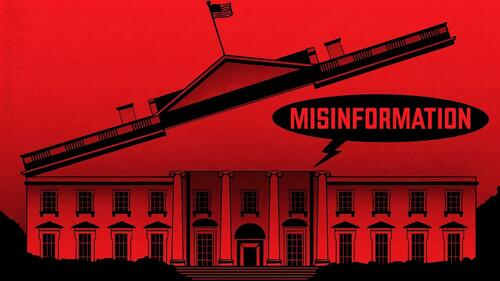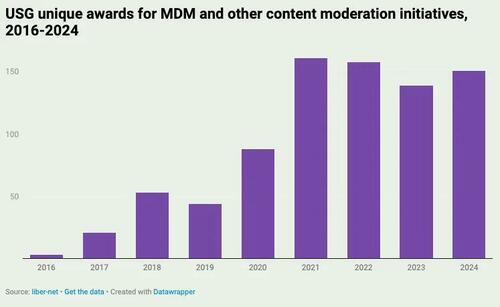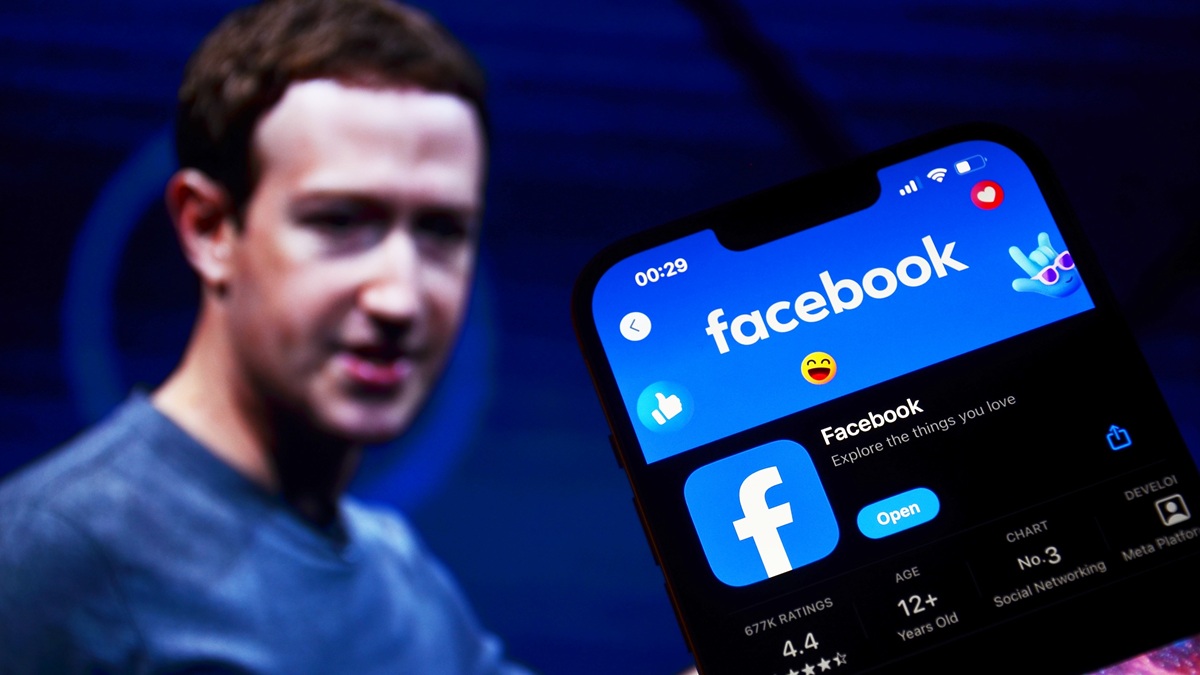
The Numbers Behind The Government’s Anti-Misinformation Explosion
Authored by Greg Collard via Racket News,
You likely already know from reading Racket that the Biden administration was very active in targeting misinformation and disinformation, even as it engaged in those practices.
 Illustration by Daniel Medina/Racket News
Illustration by Daniel Medina/Racket NewsRacket’s Twitter Files and other reporting have extensively documented many of the anti-disinformation and misinformation programs and organizations that the federal government supported, like the Election Integrity Project, Cyber Threat Intelligence (CTI League), and the Center on Narrative, Disinformation and Strategic Influence at Arizona State.
But the number of grants? We didn’t know that. Now we do.
The Free Press reports that since 2017, the federal government has awarded about 800 grants to counter mis/disinformation — and the Biden administration is responsible for more than 600 of them. The 800 grants amount to more than $1.4 billion.
The findings by reporters Gabe Kaminsky and Madeleine Rowley are based on a new database of anti-mis/disinformation programs. The database was created by the free speech advocacy group liber-net.
“A large number of these projects cynically employed the ‘misinformation, disinformation, and malinformation’ framework to counter their political adversaries, with U.S. government funding making it possible,” liber-net’s director, Andrew Lowenthal, told the Free Press.
President Trump signed an executive order on his first day in office that accused the Biden administration of violating free speech rights “under the guise” of combatting misinformation, disinformation and malinformation.
But Kaminsky and Rowley found that several of the programs were continuing under the Trump administration — at least until they started asking about the grants, as Kaminsky explains to Racket.
We reached out to agencies to understand if these programs would continue under President Trump. What we found was a groundswell of federal officials taking the information and letting us know that they were either terminating the programs, investigating them, or adjusting internal policies as to how they characterize some of these programs to ensure alignment with the President’s executive order on “restoring freedom of speech and ending federal censorship” that he signed on his first day in office. Some agencies, however, didn’t respond, or, in the case of the National Science Foundation, declined to comment.
In one example the Free Press cites, NIH director Jay Bhattacharya sent an email marked “URGENT” to employees to investigate grants and contracts related to “fighting misinformation or disinformation.”
The Free Press found several dozen grants that have since been canceled, such as $683,000 awarded to UC-Irvine in December. The money would have gone toward studying the influence of social media and “misinformation on vaccine acceptance among black and Latinx individuals.” The study would have done that by enrolling 500 people who follow vaccine-hesitant influencers on X.
Although most mis/disinformation grants occurred under Biden, they started with some regularity during the first Trump administration. Here’s a graphic from liber-net that shows how the number of grants ballooned from Trump to Biden:

The organizations that receive grants typically dole out portions of the money to other organizations. Kaminsky explains how they work:
Gabe Kaminsky: Like many federal programs, there are often subgrantees or subcontractors. So, while Maddie Rowley and I found that the Biden administration had awarded north of 600 grants and contracts to outside organizations, that number only accounts for primary awards. Take the $2 million that the Department of State awarded in 2023 to the Vermont-based NGO World Learning to, in its telling, “support the Armenian media sector’s overall resilience to disinformation.” For that program, which ended in February 2025, World Learning dished out a sub-award of $275,219, or 13% of the primary award, to the Poynter Institute.
And for Poynter, that’s nothing new. For example, I reported last year that Poynter had received a sub-award from the State Department’s since-shuttered Global Engagement Center—which Republicans accused of censoring conservatives in the United States. Poynter received the GEC funding via the Institute for War and Peace Reporting, a London-based entity.
Greg Collard: Although most grants were during the Biden administration, they were also awarded during the first Trump administration. Was there a difference in the types of grants that were awarded?
GK: Post-2017 is really when these programs were kicked into gear, speeding up dramatically under Biden. The same grantees and contractors that ended up receiving large amounts in funding under Biden often had initially received some during the first Trump administration. As to why that was is I think a mix of Republicans being in the dark as to the programs, and—as was evident broadly across the first Trump administration—there being agencies that sort of operated how they desired irrespective of Trump’s stated policies. Trump did not know how Washington worked.
However, I would say that the descriptions of programs on federal documents under Biden was a notable difference—as some appeared to more specifically align with the ideological priorities of the Democrats: using terms like “racial equity,” “Latinx,” or other left-leaning terminology championed by the Biden administration. Under Trump 1.0, in other words, the anti-misinformation circus quietly gained a foothold in the U.S. by advertising itself in broad strokes that, in theory, many might agree with: countering extremism or online harassment, for example.
But in practice, the programs were far more complicated and often partisan.
Active Grants
Although many anti mis/disinformation programs have been shut down, many remain active — including the largest grant: a $979 million award to military contractor Peraton, courtesy of the Department of Defense. Peraton landed the grant in 2021 to help the U.S. Central Command “counter misinformation,” liber-net’s Lowenthal writes in a Substack post about the database.
That grant alone easily makes the Defense Department the largest funder of mis-disinformation grants from 2016 to 2024. USAID was the second-largest funder at $149 million.
Smaller grants also remain active. One the Free Press cites is $6.8 million in multiple grants to the University of Washington for literary resources that help “rural communities and black, indigenous, and people of color (BIPOC) communities” identify misinformation. The grant description says misinformation is a “growing threat to American democracy,” and that “Solutions must not only provide the public with skills for determining the truthfulness of claims, but must also provide resources for addressing the social and emotional impacts of misinformation.”
Tyler Durden
Sun, 04/20/2025 – 11:40








